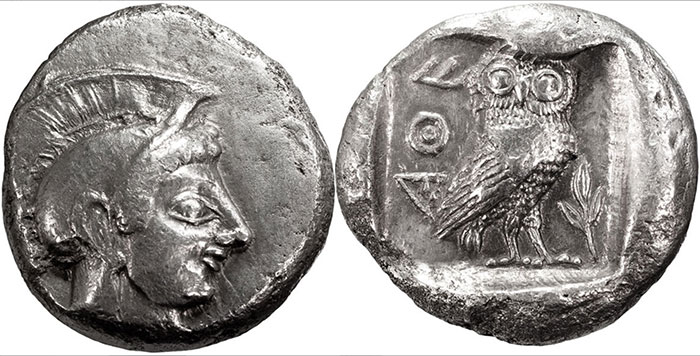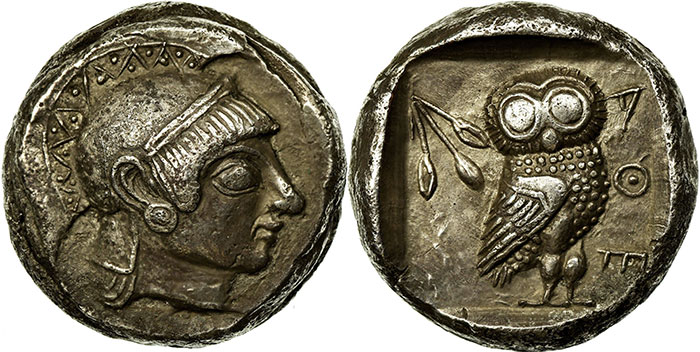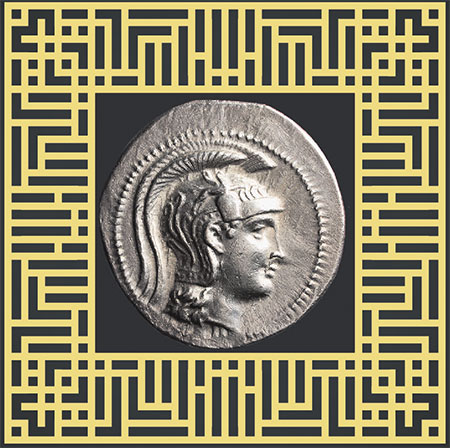By Joël van Dam – Owner, Joëlnumismatics, for MA-Shops.com ……
This blog is about one of the most iconic Greek coins ever minted, known to almost all coin collectors. It’s so famous, in fact, that this coin will also be recognized by much of the general public. It is pictured on the modern one euro of Greece and is one of the symbols of the Greek city of Athens nowadays.
I’m talking, of course, about the famous tetradrachm from Athens minted more than 2,000 years ago. Three different types can be distinguished trough time, although these types can also be differentiated into further subtypes. Here I will only discuss the three general types:
- Archaic Tetradrachm
- Classical Type Tetradrachm
- New Style Tetradrachm
Tetradrachm c. 515-510 BC Attica (Type 1)
63,000.00 USD
- Weight: 16.85 g
- Catalog: Seltman-328, Asyut-Group III
Obv: Helmeted head of Athena r. Rev: Owl standing r., head front, olive twig with two leaves before, ?T? in l. field.
Seltman’s “Civic Mint” issue, though misnamed by him and dated too late, contained some very interesting coins, including the earliest to bear the famous Athena/owl types at Athens in our opinion. According to Seltman, the tetradrachms of this group were “superior in technique and style” and “the finest medallic coins ever produced in Athens”; Athena’s features and helmet on the obverse were “carefully and effectively treated”, while the owls on the reverse were “of special merit”, “reminiscent of the style of the vase-painters of the period”. This class, in our view, was a trial or experimental group like the earliest Croesus coins.
The present coin, in particular, supports that idea, for its reverse type, struck in extremely high relief, places the olive branch at the lower right of the design rather than the upper left, as usual, forcing the ethnic to be placed to the left rather than the right of the owl. This variant type occurs only on this one reverse die, otherwise known only from a coin in Berlin published by Seltman and Svoronos, which was struck from a similar but not the same obverse die. The obverse die of this remarkable coin relates very closely to the obverses of the Persian War issues, though they are miserably made because of the massive quantity issued. Therefore, this is the last of the experimental issues.
Tetradrachm 500-490-485-0 BC, Attica (Type 1)
30,850.00 USD
- Weight: 17.30 g
- Diameter: 21.00 mm
Silver, HGC:4-1590, Archaic helmeted head of Athena right, Owl standing right, head facing; olive sprig to left, ATE to right; all within an incuse square, well struck on a broad flan, with nearly full portrait showing and full reverse lightly toned. Rare type and exceptional example of an archaic Athenian tetradrachm, unusually well struck.
Iconography
The iconography of both sides of the coin refers to the Greek goddess Athena. On the obverse, you can see the helmeted head of Athena, and on the reverse, you can see the Athenian owl who represents her. Athena was and is associated with wisdom, weaving and warfare. But she was also the patron of different cities across Greece – a1bove all with the city of Athens. So, it was a logical idea to place her on the coins of Athens since Greek cities referred to themselves using coins.
The Athenian tetradrachm was the first successful international coins. They were minted from 510 BCE until at least 42 BCE when the Romans stopped minting the Athenian coins and replaced them for their own denarii.
Tetradrachm 454-404 BC. Attica (Type 2)
1,050.00 USD
- Catalog: Kroll 8, HGC 4.1597
- Material: Silver
- Weight: 17.23 g
- Diameter: 24.00 mm
Obv: Head of Athena right, wearing earring necklace, and crested Attic helmet decorated with three olive leaves over visor and a spiral palmette on the bowl. Rev: Owl standing right, with head facing on left, crescent and olive twig with leaves and one berry, ΑΘΕ to right, all within incuse square.

Tetradrachm 353-294 BC. Attica (Type 2)
440.00 USD
- Catalog: SNG Cop. 63 HGC 1599
Three Different Types
Archaic Tetradrachm: First there were the so-called “Archaic” tetradrachms. These coins were minted from 510 BCE until 480 BCE. They have a more primitive appearance compared with later tetradrachms. The Archaic types are the most valuable because of their rarity.
Classical Type Tetradrachm: Starting in 478 BCE, the Classical type was minted until 393 BCE. These coins were minted in extreme numbers. But their style is a real piece of art. They have more details and more life in them compared with archaic types. These coins are extremely in demand. Quality and style make the price for these coins. The value varies between the €450 and €4,500 each. A small difference can make the price here! An important difference is the amount of crest that can be seen on the flan of the coin.
New Style Tetradrachm: The last general type that was minted is the New Style tetradrachm.
The iconography is the same but the style is very different. A big difference is that the owl now sits on an amphora and that he is surrounded by an olive wreath. Of course, this all refers to the international olive trade of Athens.
Many Athenian tetradrachms can be found on MA-Shops. So, if you are looking for one you will find it here!
AR Tetradrachm 139-138 BC Attica (Type 3)
2,590.00 USD
- Catalog: cf. SNG.Copenhagen 137 | cf. Svoronos, Trésor Pl.43.23
- Weight 16.92 g Silver
- Diameter: 32 mm
Obv: Head of Athena Parthenos right, wearing triple crested Athenian helmet, ornamented with griffon. Rev: Owl standing right, head facing amphora, Nikè in quadriga on right, within laurel wreath.
Tetradrachm 160 BC Attica (Type 3)
600.00 USD
- Material: Silver
- Weight: 16.92 g
- Diameter: 33.00 mm
* * *
I wish all of you a wonderful and healthy 2020. And I hope you will have a lot of pleasurable time with your great hobby and the coins that you will find on the MA-Shops website.
About MA-Shops
 MA-Shops is an internet marketplace headquartered in Europe. MA-Shops has assembled a network of reputable coin dealers – both large and small – onto one, easy-to-use platform to sell coins, paper currency, medals, military orders and stamps directly to the collector. Founded by German engineer Joachim Schwiening in 2005, MA- Shops is now the leading ”online collector mall” worldwide. Browsing through the site quickly reveals how wide and variegated the selection from MA-Shops and its associated dealers really is. In recent months, Schwiening and MA-Shops have made a concerted push into the American market.
MA-Shops is an internet marketplace headquartered in Europe. MA-Shops has assembled a network of reputable coin dealers – both large and small – onto one, easy-to-use platform to sell coins, paper currency, medals, military orders and stamps directly to the collector. Founded by German engineer Joachim Schwiening in 2005, MA- Shops is now the leading ”online collector mall” worldwide. Browsing through the site quickly reveals how wide and variegated the selection from MA-Shops and its associated dealers really is. In recent months, Schwiening and MA-Shops have made a concerted push into the American market.
- OPEN YOUR MA-SHOP and sell to 300,000 collectors
- Items listed on marketplaces and search engines, Google & Co.
- Marketing Tools, dedicated MA-Shops Support
- Email Campaigns
- Multi-Language: English, French, German, Dutch, Spanish, Italian, Russian, Chinese
Contact us here








